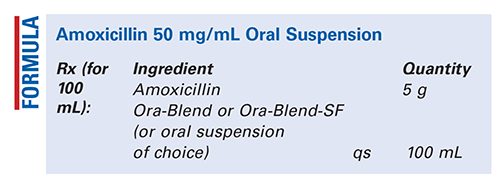US Pharm. 2022;47(12):59-60.

Method of Preparation: Note—As this is a beta-lactam product, use dedicated or disposable equipment, follow appropriate cleaning procedures, and protect from dust by wetting with suspension vehicle and using careful trituration. (See FDA guidance on compounding beta-
lactam products in shortage.1)
Calculate the required quantity of each ingredient for the total amount to be prepared. Accurately weigh or measure each ingredient. Place the amoxicillin (from commercial capsules or tablets, as per the FDA) in a mortar and add about 10 mL of Ora-Blend, Ora-Blend SF, or other oral suspension vehicle of choice; then mix carefully to form a smooth paste. Geometrically, add sufficient Ora-Blend, Ora-Blend SF, or oral suspension vehicle of choice to final volume, with thorough mixing after each addition. Package and label.
Use: Amoxicillin is used to treat susceptible bacterial infections.
Packaging: Package preparation in tight, light-resistant containers.
Labeling: Keep out of reach of children. Discard after ____ [time period]. Shake well. Refrigerate.
Stability: A beyond-use date of up to 14 days when stored in a refrigerator may be used for this preparation.2
Quality Control: Quality-control assessment can include weight or volume, pH, specific gravity, active drug assay, color, rheologic properties or pourability, physical observation, physical stability (discoloration, foreign materials, gas formation, mold growth), and preservative-effectiveness test.3,4
Discussion: Amoxicillin trihydrate (Amoxil, Larotid, Trimox, C16H19N3O5S • 3H2O, MW 419.45), an aminopenicillin, is a white or almost white, practically odorless, crystalline powder with a bitter taste. About 1.15 g of the trihydrate is equivalent to 1 g of amoxicillin. It is soluble in water at 4 ng/mL and 2.7 mg/mL, so the concentration here will be a suspension.5 A 0.2% aqueous amoxicillin solution has a pH of 3.5 to 6. Commercial oral suspensions have pH values of 5 to 7.5. Amoxicillin undergoes hydrolytic cleavage of the beta-lactam ring, especially at alkaline pH. The pH of maximum stability is 5.77. Amoxicillin trihydrate for oral suspension 200 mg/5 mL, 250 mg/5 mL (or 50 mg/mL), and 400 mg/5 mL are bubble gum–flavored pink suspensions. Inactive ingredients include FD&C Red No. 3, flavorings, silica gel, sodium benzoate, sodium citrate, sucrose, and xanthan gum.6
Ora-Blend is a sweetened oral suspending vehicle used to simplify the process involved in the extemporaneous compounding of oral suspensions. It is an aqueous-based, sweetened vehicle consisting of a synergistic blend of suspending agents that have a high degree of colloidal activity. It is buffered to a slightly acidic pH of approximately 4.2, has a viscosity of approximately 700 cps at 25°C, and has an osmolality of 2,107 mOsm/kg. Ora-Blend occurs as an opaque, pinkish liquid with a sweet citrus-berry flavor. It contains purified water, sucrose, glycerin, sorbitol, flavoring, microcrystalline cellulose, carboxymethylcellulose sodium, xanthan gum, carrageenan, citric acid, and sodium phosphate as buffers; contains simethicone as an antifoaming agent; and is preserved with methylparaben and potassium sorbate.7
Ora-Blend SF is a flavored oral suspending vehicle used in the extemporaneous compounding of oral suspensions. It is an aqueous-based, sweetened vehicle consisting of a synergistic blend of suspending agents that have a high degree of colloidal activity. The suspending agents form a structured, gel-like matrix that suspends particles and allows for little settling. It is buffered to a pH of approximately 4.2, has a viscosity of approximately 1,000 cps at 25°C, and has an osmolality of 1,073 mOsm/kg. Ora-Blend SF occurs as an opaque, pinkish liquid with a sweet citrus-berry flavor. It contains purified water, sorbitol, glycerin, flavoring, microcrystalline cellulose, carboxymethylcellulose sodium, xanthan gum, carrageenan, sodium saccharin, citric acid, and sodium citrate as buffers; contains simethicone as an antifoaming agent; and is preserved with methylparaben, propylparaben, and potassium sorbate.8
A number of different oral suspension vehicles may be used for this preparation.
REFERENCES
1. Craven J. FDA releases guidance on compounding beta-lactam products in shortage. Regulatory News. November 23, 2022. www.raps.org/news-and-articles/news-articles/2022/11/fda-releases-guidance-on-compounding-beta-lactam-p. Accessed November 23, 2022.
2. U.S. Pharmacopeia/National Formulary [current revision]. Rockville, MD: U.S. Pharmacopeial Convention, Inc; November 2022.
3. Allen LV Jr. Summary of quality-control testing for sterile and nonsterile compounded preparations, part 1: physical and chemical testing. IJPC. 2019;23(3):211-216.
4. Allen LV Jr. Summary of quality-control testing for sterile and nonsterile compounded preparations, part 2: microbiological testing. IJPC. 2019;23(4):299-303.
5. Trissel LA, Ashworth LD, Ashworth J. Trissel’s Stability of Compounded Formulations. 6th ed. Washington, DC: American Pharmacists Association; 2018:39-40.
6. RxList. Amoxicillin. www.rxlist.com/amoxicillin-drug.htm. Accessed November 23, 2022.
7. Ora-Blend product information. Allegan, MI: Perrigo; 2018.
8. Ora-Blend SF product information. Allegan, MI: Perrigo; 2018.
The content contained in this article is for informational purposes only. The content is not intended to be a substitute for professional advice. Reliance on any information provided in this article is solely at your own risk.
To comment on this article, contact rdavidson@uspharmacist.com.





